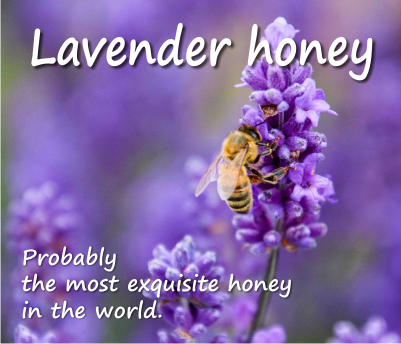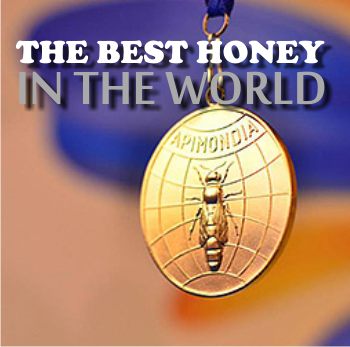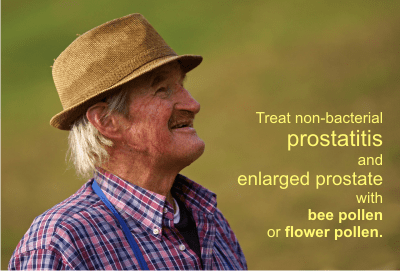Morocco is one country that knows to appreciate honey. Euphorbia honey (aka Spurge honey or Daghmous Honey) is used a lot in traditional medicine for sore throats, cardiovascular disease, allergic asthma, digestive issues and infertility.
Euphorbia, aka spurge, is one of the largest genera of flowering plants in the spurge family (Euphorbiaceae). With over 2,000 species, euphorbias can range from tiny annual plants to large and long-lived trees and look completely different. Even the beautiful Poinsettia, that we know as Christmas Star, belongs to this huge euphorbia family. Some are used as ornamentals in landscaping, because of beautiful or striking overall forms but also for their drought and heat tolerance.
In the deserts of Africa and Madagascar, euphorbia adapted its physical characteristics and forms and became similar to cacti of America, yet they are not cacti.
Morocco is a North African country well-known for its long beekeeping tradition, not for quantitative production, because they are still importing honey every year, but for their diverse types of honey and its use in traditional medicine. Moroccans make eucalyptus, thyme, spurge, citrus, carob tree and oregano (the best in the world) honeys. Their favorite are thyme and spurge (euphorbia).
80% of the productivity is due to traditional beekeeping.
Three races of bees live in Morocco: Apis mellifera intermissa present in most regions, Apis mellifera major in the Rif mountains in the North (considered as an ecotype, not differing from Apis mellifera intermissa in behaviour and its taxonomic status) and Apis mellifera sahariensis in the South (the ones that are found more in oases, producing Sahara honey).
Euphorbia – the floral source of spurge honey
There are many species of euphorbia in Morocco, but three of them are much enjoyed by honey bees:
Euphorbia resinifera, Euphorbia echinus, Euphorbia regis-jubae.
The botanical name Euphorbia derives from the Greek Euphorbus, in honor of the physician of Juba II, a Romanized king of Mauritania who was supposed to have used in his treatments a plant (E. resinifera) with milky latex and powerful medicinal properties.
• Euphorbia resinifera, the resin spurge, is a species of spurge native to Morocco, found on the slopes of the Atlas Mountains. The dried latex of the plant has been used as ancient medicine. It contains resiniferatoxin, a capsaicin analog tested as an analgesic since 1997 and currently tested to treat pain with advanced cancer. Resiniferatoxin or RTX, is a thousand times hotter on the Scoville scale than pure capsaicin, the chemical that produces heat in hot peppers.
Both the capsaicin from hot peppers and the resiniferatoxin from the Euphorbia can give you chemical burns or even kill you, but they all may be used for pain relief.
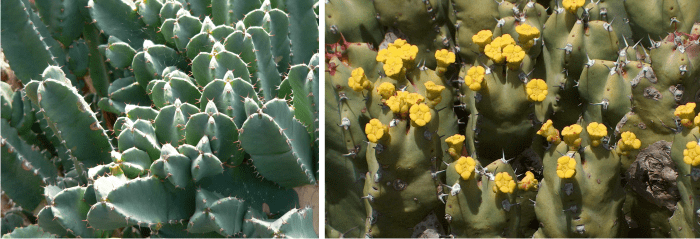 Euphorbia resinifera pictures credit I, BS Thurner Hof and Valérie & Agnès
Euphorbia resinifera pictures credit I, BS Thurner Hof and Valérie & Agnès
Euphorbia resinifera Honey aka Daghmous Honey (Miel Pur De Darmous) aka Honey of Daghmous Cactus
It is produced on the slopes of the Atlas Mountains and the one made in Tadla-Azilal area, known as “Zaggoum honey” in Moroccan Arab language or “Tikiwt honey” in Amazigh language, is one the most characteristic and preferred for consumption and traditional medicine.
This monofloral honey is characterized by a low intensity floral odor of phenol and a unique and specific flavor of Euphorbia plant. It has a bitter and peppery taste in the throat and its color is dark golden. It is produced in Euphorbia resinifera endemic mountain zone. The union beekeepers cooperatives in the Tadla-Azilal region (U.C.A.T.AZ) scored Euphorbia resinifera honey in the labeling process and success to asset the sesame of protected geographical indications “PGI” in 2013. In addition, this label was published in the European Union Official Journal through the public consultation documents on geographical indications of the Kingdom of Morocco.
According to the Moroccan and European food safety and food quality standards, the monofloral Euphorbia resinifera honey of Tadla-Azilal region is of good quality with regards to pesticides and heavy metal residues. This also denote that the “PGI” production area of Euphorbia resinifera honey is not polluted by these chemicals and confirm the “mountain honey” label.
Color: from golden yellow to dark amber.
Taste: sweet, pinch in the throat with a typical light bit back flavour.
Aroma: spicy almost peppered and sometimes hot
Flavor: pungent
According to a study from 2011 conducted by Amina Chakir, here are the main characteristics of Euphorbia resinifera:
Water content: 17.06 %
pH: 4.23
Free acidity: 18.24 meq/kg
total acidity: 26.07 meq/kg
HMF content: 12.08mg/kg
Diastase: 12.67 ° Gothe
Electrical conductivity: 410.62 μs cm−1
Fructose: 40.85 %
Glucose: 29.98 %
Sucrose: 0.97 %
This honey is generally used as a treatment for sore throat and as a toning up. It is one of the few honeys used as treatment against asthma.
 • Euphorbia echinus (Euphorbia officinarum ssp. echinus), is endemic to Morocco, Western Sahara and Mauritania. It is an evergreen shrub with thorns and succulent that reaches about a meter in height. Its stems, branched candelabra shape are green and covered with short white spines. The cyathia or false flowers of this plant are maroon and sometimes yellow, appearing in summer. Although the milky latex may be toxic, the plant is also said to be used medicinally in the treatment of ovarian cysts.
• Euphorbia echinus (Euphorbia officinarum ssp. echinus), is endemic to Morocco, Western Sahara and Mauritania. It is an evergreen shrub with thorns and succulent that reaches about a meter in height. Its stems, branched candelabra shape are green and covered with short white spines. The cyathia or false flowers of this plant are maroon and sometimes yellow, appearing in summer. Although the milky latex may be toxic, the plant is also said to be used medicinally in the treatment of ovarian cysts.
In Morocco E. echinus is present more in the Agadir and Tiznit surroundings.
In the studied samples of Euphorbia echinus honeys, the most characteristic accompanying species are Eryngium ilicifolium, present in more than 90% of the samples, followed by Bellis sp., Capsella f. and Reseda sp. (study).
Euphorbia ehinus honey has a unique taste and has a slightly bitter aroma. It has values of colour, free acidity, HMF, diastase and electrical conductivity higher than those of E. resinifera honey (Amina Chakir, 2011).
Water content: 17.88 %
pH: 4.22
Free acidity: 24.16 meq/kg
total acidity: 32.86 meq/kg
HMF content: 20.32 mg/kg
Diastase: 17.25 ° Gothe
Electrical conductivity: 582.49 μs cm−1
Fructose: 41.70 %
Glucose: 28.33 %
Sucrose: 1.05 %
• Euphorbia regis-jubae is native to the eastern Canary Islands, western Morocco and north-western Western Sahara. In Spanish, it is known as tabaiba morisca. It has often been confused with Euphorbia lamarckii. It is a shrub, up to 2 m (7 ft) tall. It has light brown stems and terminal rosettes of leaves that are narrow and oblong, with a pointed or somewhat blunt apex. The flowers are greenish-yellow, pedunculate, umbel-like, usually simple with five to eight rays.
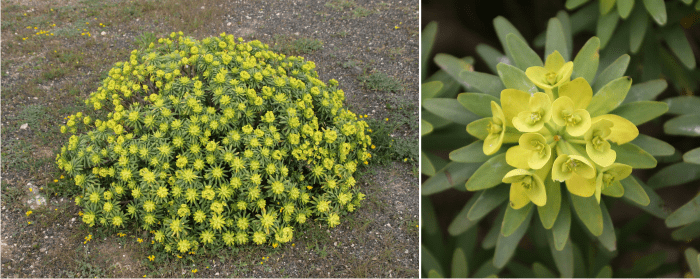 Euphorbia regis-jubae pictures credit Frank Vincentz
Euphorbia regis-jubae pictures credit Frank Vincentz
Euphorbia regis-jubae honey also contains pollen from Crepis f., a characteristic accompanying species, present in 100% of the samples. (study)
In a study conducted by Ismail Bettar in 2015, two euphorbia honeys were evaluated in order to distinguish them by their physicochemical characteristics, mineral contents and color. The 2 euphorbia honeys were sourced in Euphorbia officinarum subsp. echinus and Euphorbia regis-jubae.
According to this study here are the main characteristics of Euphorbia regis-jubae:
Water content: 18.52% (The water content is related to climatic conditions, the season and the degree of maturity (White, 1975, Bogdanov et al., 1999)
pH: 3.79
Acidity: 40.36 meq kg−1 – below the EU limit of tolerance. (Acidity is due to the presence of organic acids and inorganic ions such as gluconic acid with their lactones or esters, phosphate and chloride.)
HMF: from 0.75 to 25.92 mg/kg
Ash content: from 0.03 to 0.24
Electrical conductivity: between 322 and 690 μS cm−1 (electrical conductivity is closely related to the concentration of mineral salts, organic acids and proteins. This parameter varies greatly according to the floral origin, so it is considered one of the best differentiating parameters to classify honeys regarding their floral origin)
Mineral content:
Potassium (K) : x‾=687mg/kg, the most important mineral (66% of total minerals quantified),
Sodium (Na): 20% of total minerals (264 mg/k)
Calcium (Ca): 11% of total minerals
Magnesium: 2% (13.7 mg/kg)
Aluminium: 1.5%
Iron: 0.5%
Studies showed that these honeys have very low or none traces of heavy metals (Pb, Hg and Cd) and are free of pesticides residues (insecticides, fungicides, varroacides and others).
Euphorbia Honey Health Benefits
Euphorbia honeys are known for their anti-inflammatory, analgesic and antibacterial properties, as well as their capacity to promote wound healing (Khiati et al., 2013).
Euphorbia honey is famous for its medical action as a tonic and to soothe a sore throat. It is also one of the very few honeys to treat allergic asthma in people who are sensitive to pollen or propolis. In Moroccan traditional medicine it is used for hypertension, cardiovascular diseases, allergic asthma but also to promote female fertility.
It is considered that spurge honey contains the necessary nutrients for our nutritional balance and helps with digestion and the absorption of fats.
It is also considered to aid as a sexual revitalizer.
E. resinifera honey has strong antimicrobial activity on bacterial strains (Noaman et al., 2004);
Euphorbia honey is used to cure infertility in a recipe that also uses palm pollen and royal jelly. Here it is, according to afrikorientshop.com.
Mix well 1 tablespoon of palm pollen (about 30g) in 100g of honey. You can also add one tablespoon of oil of Nigella sativa to allow the mixing more easily.
A woman should take 1 teaspoon of this mixture every morning, during ovulation period. For better results take it for a 1 month cure treatment. If the man has a problem of spermatozoa, he should take it every day for about 1 month. If he does not have spermatozoa concerns, he should start the cure 5 days before the ovulation period of his wife and do not consume for 5 days.
(the palm pollen contains estrogen hormones. make you you don’t have ovarian cysts or other diseases that prohibit taking them.)
There are still concerns regarding the presence of some toxic compounds in the flowers’ nectar, because the intracellular latex-secretion and the extracellular nectar-secretion are anatomically connected in the spurge species.
As the latex of Euphorbia species contains several toxic compounds, the secretion of these compounds into the nectar and finally into the honey may cause medical problems. That’s why further toxicological and pharmacodynamic examinations of mixed honeys containing Euphorbiahoney are much recommended (Tóth-Soma et al., 1993).
Where can we find euphorbia honey?
If you want to find euphorbia honey online, remember to search after all its names: spurge honey, cactus honey, Daghmous Honey, Miel Pur De Darmous, Zaggoum honey, Tikiwt honey. (If you know others please let me know.) Here are some shops: nectarome.com, africorientshop.com, biomielandco.com. Moroccanlegacyuk com used to sell it as well, but then it disappeared. Yet you may check it from time to time, maybe they’ll bring some more.
*********
*********
References:
https://en.wikipedia.org/wiki/Euphorbia_resinifera
https://www.jmaterenvironsci.com/Document/vol8/vol8_N5/194-JMES-3049-Moujanni.pdf
Characterisation of Moroccan Spurge (Euphorbia) honeys by their physicochemical characteristics, mineral contents and colour, by IsmailBettar et al., 2015, published on sciencedirect.com
Physicochemical properties of some honeys produced from different plants in Morocco, by AminaChakir et al., 2011, published on sciencedirect.com
Quantification of heavy metals and pesticides residues in labeled Moroccan Euphorbia resinifera honey from Tadla-Azilal, by A. Moujanni et al., 2017, published on jmaterenvironsci.com;
https://operationwildflower.org.za/index.php/albums/euphorbias/euphorbia-echinus-1076
https://www.thoughtco.com/hottest-chemical-resiniferatoxin-3975976


